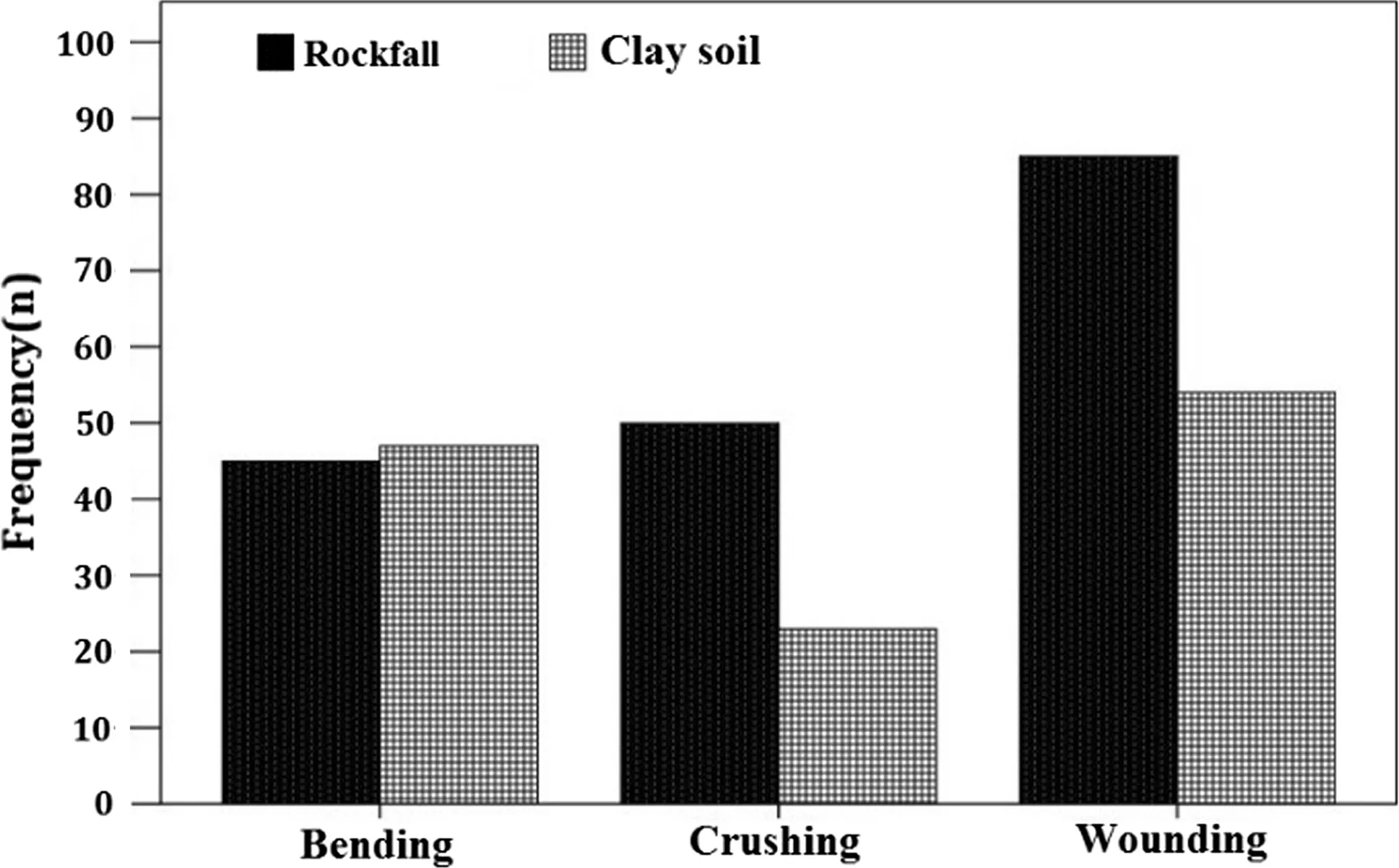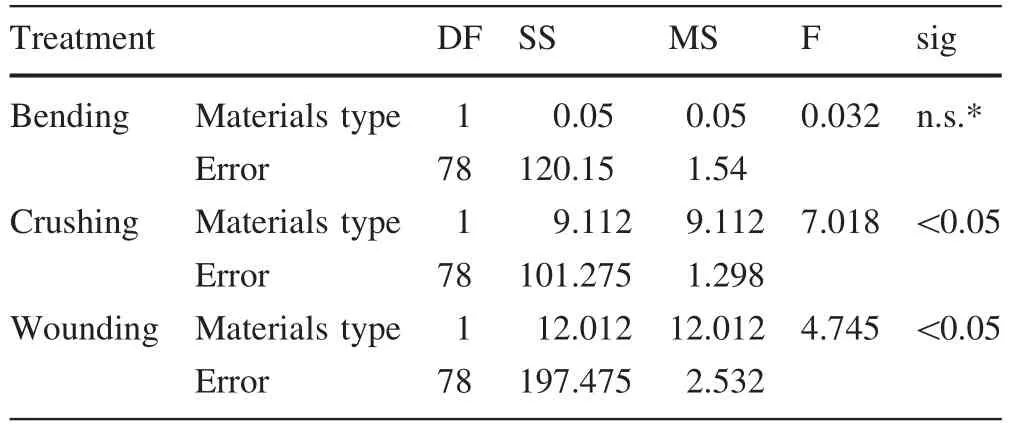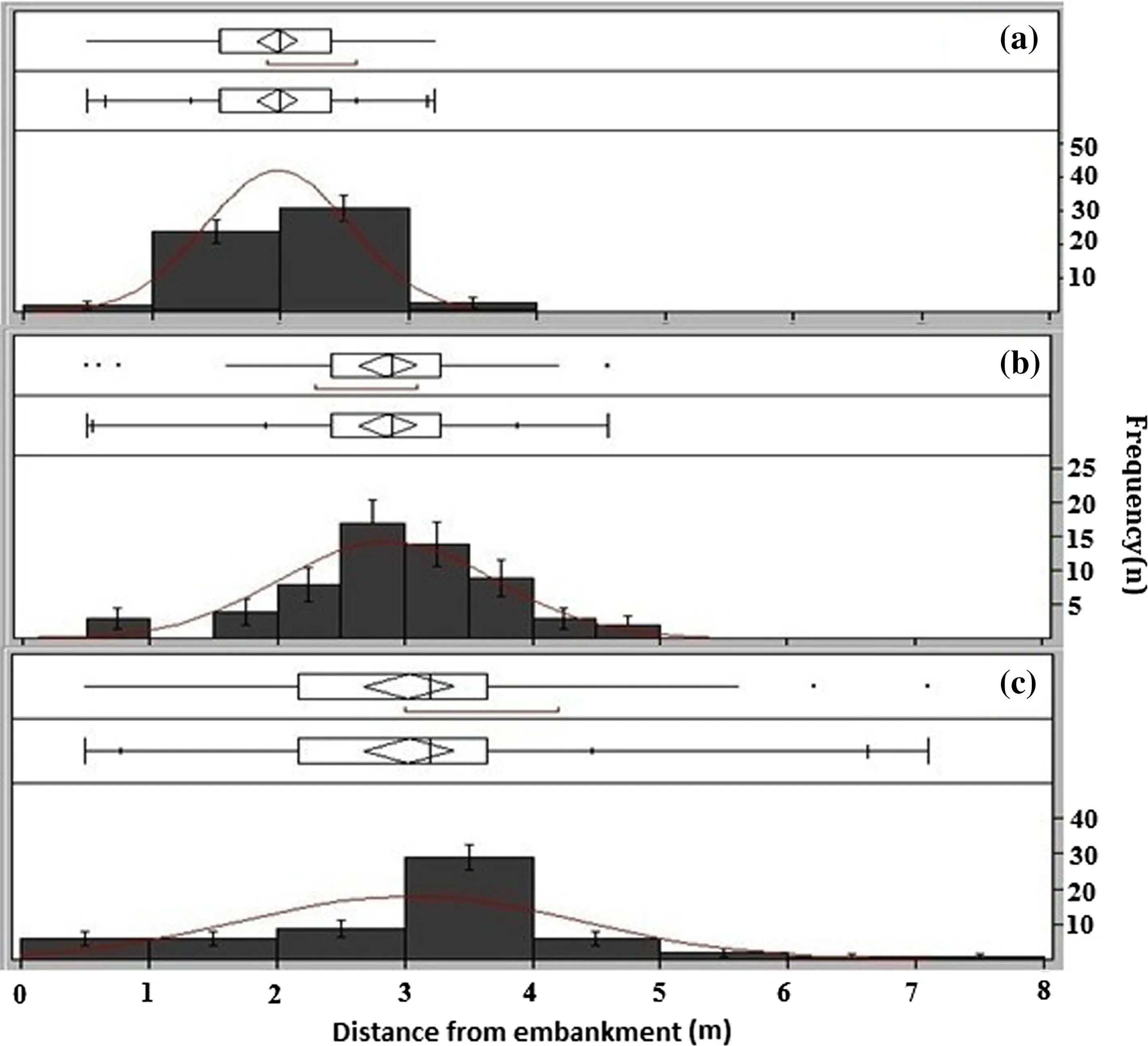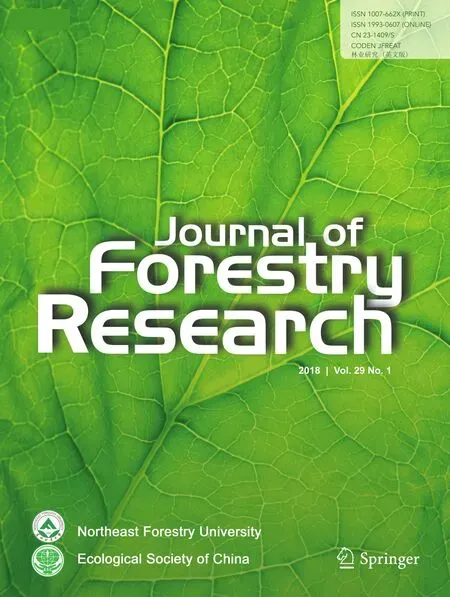The distribution and frequency of damage to roadside trees in low-volume road construction
Majid Lotfalian·Mehran Nasiri
Introduction
Forest road networks are important in transportation of timber and forest management.Road construction in forest areas especially in mountains typically causes the destruction of natural habitats(Bernhardt-Romermann 2006;Spooner and Smallbone 2009;Farhig and Rytwinski 2009;Mullerova et al.2011;Bargali et al.2014,2015).Some adverse effects are direct and immediate(Joshi et al.1997;Kittur et al.2014;Rana et al.2015).The loss of the part of forest on which the road is built causes direct and immediate consequences such as damage to tree stands and grass cover(Benitez et al.2010;Avon et al.2013),damage to hydrology and increasing sediment delivery(Croke et al.2005),slope instability and landslide creation(Borga et al.2005),soil mass wasting and creep.Additional gradual and indirect effects can be caused by forest roads.Habitat fragmentation(Benitez et al.2010),water and soil pollution due to forestry machinery traf fic(Cornish 2001),and avoidance by birds due to increased noise are the most frequent examples.
Road construction on natural hillsides requires earthworks.Despite careful engineering of hillside length,slope gradient,and right of way,the loss of habitat causes public discontent and criticism.One of the main sources of adverse impact is steep slopes(Cao et al.2010;Melemez 2013).On highslopestheef ficiencyofmachinessuchasbulldozersand hydraulic excavators is reduced(Parsakhoo 2008;Ozturk et al.2010;Caliskan 2013).Working on steep or rock slopes can reduce operator ef ficiency,cause failure to comply with design standards,andultimatelyresultinfaulty construction(Heralt2002;Parsakhoo2008).Increasingoperatorerrorcan increase rock fall due to rock mass collapse and soil mass movement during road construction.Several studies have been accomplished aboutformation,rock mechanics(Marquinezetal.2003;Dorrenetal.2005;Perretetal.2004)and preventing rock falls conditions(Brauner et al.2005;Stoffel et al.2006).They stated that analysis and simulation of rockfall to investigate rockfall trajectories and management of rock fall using predictive GIS-based model can reduce the environmental destruction.In other studies,the effects of earthwork on tree stands during forest road construction were examined(Gumus et al.2009;Ozturk et al.2010;Caliskan 2013;Melemez 2013).In these studies,the amount of damage(bending,crushing and wounding)to the trees were studied according to the distance from fillslope,hillside gradient and road construction machinery such as hydraulic excavator and bulldozer.Gumus et al.(2009)stated that 90.48%of damaged trees were in the first 10 m afterthebeginningofthe fillslopeslope.Averageinjuryarea ofthedamaged trees wascalculatedas1081 cm2forthe first 10 m from the fillslope slope and an injury area of 1463 cm2was calculated for between 11 and 23 m on the fillslope slope.Hillside gradient and materials are very effective in treesdamageonroadside.Cohesionofsoilandrockparticles canincreasetheslopestability(BehniaandTabatabai2009).Also,thegradientofslopeisveryeffectiveinspeedoffalling rock and soil masses.Due to the importance of the slope gradient and hillside materials,the purpose of this study was to investigate the distribution and frequency of various damage(bending,crushing and wounding)to the trees adjacent to forest roads according to the type of hillside materials involved(soil and rock)and hillside gradient.
Materials and methods
and sliding of construction material were studied(Fig.1).Plots with variable width(due to damaged trees)and 50 m length(due to road slope)were considered in 17 km constructed road.Forty plots were systematic randomly selected for hillside with clay soil and also 40 plots for rock slopes.To measure the environmental damage,damaged tress(diameter at breast height(DBH)more than 8 cm)on the roadside were counted.To investigate the slope gradient on the rate of damage,plots were chosen in slope classes of 0–15%,15–30%,30–45%and more than 45%.Plot width was considered variable to determine the damaged trees distribution.Therefore,the distance from fillslope(out of earthwork area)to damaged trees were measured with a tape and damage frequency were recorded(Gumus et al.2009).The results were analyzed by SPSS and JMP4 software.So the effect of materials type(soil or rock)and slope classes on the rate of environmental damage for each treatment(type of damage)were studied using t-student test and One-way ANOVA analysis in SPSS,respectively.In order to investigate the distribution of treatments(damaged trees according to the distance from the fillslope)the Distribution command of JMP4 software was used and the results were analyzed.
Results
The result of frequency data indicated that earthwork caused fewer damage to adjacent trees and most of the damage was wounding.Also the frequency of tree wounding and crushing on the verge of rock slopes was more than clay soil hillsides(Fig.2).There was a
Study area
This study was conducted in a road of Caspian forests(in northern forests of Iran).Trees on the roadside were mostly Alder and Hornbeam.The study area was located in mountainous regions,general slope was normally less than 60%and the altitude was between 1100 and 1820 m.In these regions,construction of roads is dif ficult due to changes in topography.The type of soil was brown soil and in high altitude the soil depth w about 5–10 cm.In these region the road construction progress would be slow due to the presence of stone walls.Also the use of advanced machinery is not recommended due to economic reasons(low work volume)and environmental concerns.Therefore,most of the earthwork is performed by Komatsu D135 bulldozer and in some circumstances hydraulic excavator.
Measurements

Fig.1 Damaged trees due to road construction in forest areas
In this research,some environmental damage such as bending,crushing and wounding of trees due to con fliction signi ficant difference between trees crushing and wounding based on materials type(p<0.05),but this difference was not signi ficant for trees bending(Table 1).
Hillside gradient has a large impact on the amount of damage to adjacent stands.With increasing the slope,the amount of damaged trees would be increased and its impact on trees crushing and wounding would be greater(Fig.3).So that there was a signi ficant difference(p<0.05)between slope classes of more than 45%and other classes in terms of damage associated with crushing(except slope class of 30–45%)and wounding.But this difference is not signi ficant for trees bending in different slope classes.Damage to trees on the hillsides with a slope of>45%were 2,8.5 and 2.3 times more than hillsides with a slope of<15%for bending,crushing and wounding,respectively(Table 2).
By monitoring the distribution of damage and distance from the fillslope it could be found that damage range was different due to its types and the maximum distribution was allocated to trees wounding.So up to 8 m from fillslope wounded trees could be observed.The measurements indicated that most damage due to collision of material with trees at the edge of road had occurred in 4,5 and 8 m from the fillslope for tree bending,crushing and wounding,respectively(Fig.4).Statistical comparison of the damage distribution according to materials type(rock or clay soil)showed that there was a signi ficant difference for wounding treatment(p<0.05).Meanwhile,there was no signi ficant difference in other two treatments(trees bending and crushing distribution) depending on materials types(Table 3).

Fig.2 The frequency of damaged trees according to hillside materials

Table 1 ANOVA table for statistical comparison of damaged trees on the roadside according to hillside materials
Discussion
Road construction in mountainous and forest areas will cause irreparable damage(Cao et al.2010;Mullerova et al.2011).Removal and movement of soil to construction of new path can cause environmental ruination.In most cases,damage to adjacent trees have occurred due to falling rock and mass of soil during road construction which is in agreement with Gumus et al.(2009),Ozturk et al.(2010),Melemez(2013)and Caliskan(2013).
During earthworks by hydraulic excavator or bulldozer,there is a high possibility of sudden segregation of stone stratum from the cut slope.Clay soil can be separated from hillsides smoothly.The collapse type of this stone stratum based on cleavage and fraction angle would cause tree crushing and wounding at the edge of rock slopes more than hillsides with clay soil component.
Rock and soil masses which are falling will increase in speed due to high slope and cause damage to adjacent trees by the road.Higher slope,coarse aggregates and larger stone could cause more trees crushing in close distances.The results showed that trees crushing on slopes more than 45%were more than lower slope.The possibility of various damage occurrence on higher slope is greater than lower ones because of more collision.Therefore,according to the results it could be found that by increasing the slope,damaged trees on the roadside will be increased.The result is consistent with Caliskan(2013).By examining the bulldozer and hydraulic excavator function on different slopes they have indicated that the damage to adjacent stands on higher slope were increased due to declining in operator accuracy.On hillside with slope of 30–50%,they measured 21 and 33%damaged trees for hydraulic excavator and bulldozer,respectively.This percentage of damage on hillside with slope of 51–80%has become 27 and 44%for hydraulic excavator and bulldozer,respectively.Thus,hillside gradient could be undoubtedly introduced as the major factor of nature destruction in road construction.
Damage distribution to the tree stands at the road buffer is highly affected by road construction machinery and operator accuracy,materials type and terrain slope.The type and intensity of damage will vary from road into the stands.During earthworks when rocks fall,after traversing some distance these materials would be stopped bycollision with different obstacles.At the beginning of the route due to the high speed and intensity of collision,the possibility of trees bending and crushing is high(in 4 and 5 m distances)and after traversing some distance(8 m)by decreasing in speed and finally kinetic energy and converting to potential energy(K=U)the collision intensity will decline and wounded trees will be more visible.The result is in agreement with Gumus et al.(2009).They stated that 90.48%of damage to the adjacent stand had occurred in the first 10 m of the fillslope.Also considering the effect of materials type(stone or clay soil)soil masses would collapse and stop after traversing some distances butthe stones could traverse longer distances due to more strength.Hence,stone could traverse longer distances than soil masses and cause more tree damage in further distances from the rock slopes.

Fig.3 The rate of damage to trees according to hillside gradient

Table 2 Statistical comparison of different types of damage to the trees according to hillside gradient

Fig.4 Distribution of tree damage according to the distance from fillslope:a Bending,b crushing and c wounding

Table 3 ANOVA table for statistical comparison of damage distribution depending on materials types
Conclusion
Road construction in mountainousareascan cause irreparable damage to the trees in a buffer of roadside.It must also be noted that according to the close to nature method(usual method in Iran),forest engineers emphasis that presence of road is essential for forest management.At least in the mountain forests of northern of Iran many operations related to industrial wood transportation are not possible without using roads.Therefore,to improve wood production and providing required timber for markets,the acceptance of damage could economically be justi fied.However,forest engineers by using various techniques of road designing and construction seek to minimize these bad consequences.In order to reduce environmental effects,routing and construction of roads in areas with low slope and terraces is recommended.Also,using suitable machines for earthworks and highly skilled operators are essential.If during routing of road some places were diagnosed as negative and dangerous points,it is better to use special tree covers or obstructions(wooden obstruction and synthetic holder)in order to prevent the collision of stones and soil masses.
Avon C,Dumas Y,Berges L(2013)Management practices increase the impact of roads on plant communities in forests.Biol Conserv 159:24–31
Bargali K,Joshi B,Bargali SS,Singh SP(2014)Diversity within Oaks.Int Oaks 25:57–70
Bargali K,Joshi B,Bargali SS,Singh SP(2015)oaks and the biodiversity they sustain.Int Oaks 26:65–76
Behnia K,Tabatabai M(2009)Soil mechanics.University of Tehran Press,Tehran,p 345
Benitez-lopez A,Alkemade R,Verweij PA(2010)The impacts of roads and other infrastructure on mammal and bird populations:a meta-analysis.Biol Conserv 143:1307–1316
Bernhardt-Romermann M(2006)Changed vegetation composition in coniferous forests near to motorways in Southern Germany:the effects of traf fic-born pollution.Environ Pollut 143:572–581
Borga M,Toneli F,Fontana G,Cazorzi F(2005)Evaluating the in fluence of forest roads on shallow land sliding.Ecol Model 187:85–98
Brauner M,Weinmeister W,Agner P(2005)Forest management decision support for evaluating forest protection effects against rock fall.For Ecol Manag 207:75–85
Caliskan E(2013)Environmental impacts of forest road construction on mountainous terrain.Iran J Environ Health Sci Eng 10:1–8
Cao S,Ye H,Zhan Y(2010)Cliff roads:an ecological conservation technique for road construction in mountainous regions of China.Landsc Urban Plan 94:228–233
Cornish PM(2001)The effects of roading,harvesting and forest regeneration on stream water turbidity levels in a moist eucalypt forest.For Ecol Manag 152:293–312
Croke J,Mockler S,Fogarty P,Takken I(2005)Sediment concentration changes in runoff pathways from a forest road network and the resultant spatial pattern of catchment connectivity.Geomorphology 68:257–268
Dorren LKA,Berger F,Hir C,Mermin E,Tardif P(2005)Mechanisms,effects and management implications of rock fall in forests.For Ecol Manag 215:183–195
Farhig L,Rytwinski T(2009)Effects of roads on animal abundance:an empirical review and synthesis.Ecol Soc 14(1):21
Gumus S,Aricak B,Eenez K,Acar HH(2009)Analysis of tree damage caused by rock fall at forest road construction works.Croat J For Eng 30:151–158
Heralt L(2002)Using the ROADENG system to design an optimum forest road variant aimed at the minimization of negative impacts on the natural environment.J For Sci 48:361–365
Joshi M,Bargali K,Bargali SS(1997)Changes in physico—chemical properties and metabolic activity of soil in popular plantations replacing naturalbroad leaved forests.JArid Environ 35:161–169
Kittur B,Swamy SL,Bargali SS,Jhariya MK(2014)Wildland fires and moist deciduous forests of Chhattisgarh,India:divergent component assessment.J For Res 25(4):857–866
Marquinez J,Menendez DR,Farias P,Jimenez SM(2003)Predictive GIS-based model of rock fall activity in mountain cliffs.Nat Hazards 30:341–360
Melemez K(2013)An environmental assessment of forest stands damage caused by excavators during road construction in Beech forests.Int J Environ Sci Technol 10:645–650
Mullerova J,Vitkova M,Vitek O(2011)The impacts of road and walking trails upon adjacent vegetation:effects of road building materials on species composition in a nutrient poor environment.Sci Total Environ 409:3839–3849
Ozturk T,Inan M,Akay A(2010)Analysis of tree damage caused by excavated materials at forest roads construction in Karst region.Croat J For Eng 31:57–64
Parsakhoo A(2008)Comparison of bulldozer and hydraulic excavator performance in constructing the secondary forest roads.MSc Thesis.Department of Forestry,Faculty of Natural Resources,Mazandaran University.Sari,Iran
Perret S,Dolf F,Kienholz H(2004)Rock fall into forests:analysis and simulation of rock fall trajectories consideration with respect to mountainous forest in Switzerland.Landslides 1:123–130
Rana S,Bargali K,Bargali SS(2015)Assessment of plant diversity,regeneration status,biomass and carbon stock in a Central Himalayan cypress forest.Int J Biodivers Conserv 7(6):321–329
Spooner PG,Smallbone L(2009)Effects of road age on the structure of roadside vegetation in south-eastern Australia.Agr Ecosyst Environ 129:57–64
Stoffel M,Wehril A,Kuhne R(2006)Assessing the protective effects of mountain forests against rock fall using a 3D simulation model.For Ecol Manag 225:113–122
 Journal of Forestry Research2018年1期
Journal of Forestry Research2018年1期
- Journal of Forestry Research的其它文章
- Vascular bundle connection between seed stalk and seed coat of Caragana arborescens
- Robust optimization for volume variation in timber processing
- Modelling the spatial distribution of snake species in northwestern Tunisia using maximum entropy(Maxent)and Geographic Information System(GIS)
- Population and genetic diversity of Tibetan red deer based on fecal DNA
- An evaluation of harvesting costs in present and planned operations:case study—Waston District of Mazandaran Wood and Paper Industries
- Application of site-speci fic biomass models to quantify spatial distribution of stocks and historical emissions from deforestation in a tropical forest ecosystem
